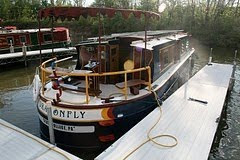(Guest blog from Bill). When we bought her, we couldn’t lock Dragonfly’s stern doors from the outside. To secure the boat, we’d latch the stern doors from the inside, walk forward through the boat, and exit through the (lockable) galley doors into the canvas-enclosed bow. There, we would unzip the canvas, wiggle out, rezip, and go ashore. Not too inconvenient, at least when tied to a long dock wall in some cute little town on the Erie Canal, with the bow and the stern both accessible from the dock.

Since we left the Erie Canal, it has usually been easier to exit and enter the boat at the stern. At marinas, we generally back the boat in between finger docks and position the stern against the main dock. This geometry makes it easier to socialize with other dockside boaters, and facilitates loading and unloading supplies and gear.
But to enter the boat when it was locked up, we still had to come in through the bow at the other end of the boat, which, depending on where we were, might mean traversing a slippery exterior walkway in the dark, with the deck pitching up and down in the surf, pirate cannon-fire all around, sharks circling beneath—you get the picture.
I grew up in Apulia Station, New York, a village so rural that, when I was a child, not only did we not lock our doors, some of our neighbors would walk into the house any time of day without even knocking. The only time that we locked the car was zucchini season, to prevent people from leaving oversize garden squash on the seat as gifts. (Actually, that’s not true; that’s a story I stole from Christine Cunningham about Bennington, Vermont. But I’m sure she stole it from someone else, so feel free to use the story yourself.)
Anyway, with my rural background, the way that I proposed to deal with
Dragonfly’s security shortcomings was to sometimes leave the stern door unlocked. “Honey,” I’d say to the First Mate, “we’re just going to the end of the pier. There’s no need to lock the boat.” After all, from the Apulia Station perspective, locking the boat is like publicly announcing, “I don’t trust you people in this marina/at this dock/in this town.” Why would you do that? Your neighbors are the people who
look after your house when you’re away.
Cynthia grew up in urban Springfield, Massachusetts. When she was a child, her neighborhood was still relatively charming and safe, but by the time the two of us met, the “neighbors” who would walk into a house in her hometown neighborhood without knocking were leaving with the valuables. So the fact that Cynthia has a different personal-comfort security threshold is understandable. “Honey,” she would say to me, “everything we need to survive for the next 12 months is on the boat. Can we
please lock up?” From a Springfield perspective, leaving our doors unlocked was like offering free job-training for miscreants and felons.
Figuring out how to lock the stern doors was challenging. Unlike a conventional house door, the two steel doors swing out and an abutting roof hatch (which clears your head as you descend the stairs) slides forward. So three different moving parts must be secured. And because we might still reboard from the bow, it was important that the exterior locking system not prevent egress. In a fire on a boat, you want as many exits as possible.
In hindsight, the solution was pretty simple, even though it took weeks of head-scratching. We drilled a hole in one of the exterior steel tracks on which the roof hatch slides. To lock the boat from outside, we slide open the roof hatch, reach down into the boat, and secure the steel doors. We then slide the hatch closed and put a weatherproof padlock through the hatch-slide hole (see photo). If people are on the boat with the padlock in place, the roof hatch won't slide, but they can still open the steel doors and exit. So the arrangement is both secure and fire-safe. The only downside to the system is that when we leave the boat, we have to attach a padlock to the hatch slide. I usually try to shield this activity with my body so that our marina neighbors won’t think we don’t trust them.
Our first night at the Dog River Marina in Mobile, we ran some errands, returned after dark, and met the night watchman, Oscar. We chatted with him for quite a while about the community, the marina, and our boat, enjoying his perspective and his southern drawl. But although Oscar's job includes looking after the security of the marina and the boats therein, we were still taken a little aback when he asked us point-blank, “How do you lock your boat?”
The First Mate and I stood there for a few seconds, trying to figure out how to respond. What a strange question. Does he want to hear the whole saga of how we secure the hatches? And just exactly why does he need to know? Would it be neighborly to tell him all about it? He’s obviously a trustworthy person; after all, he’s the night watchman.
After opening and closing my mouth a couple of times, I came up with the right response. “Just fine,” I said, “We like our boat just fine.”

























